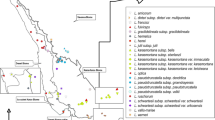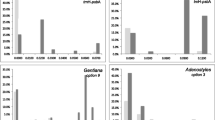Abstract
Randomly amplified polymorphic DNA (RAPD) was used to examine genomic diversity in taxa of the neotropical legume genusLeucaena. Data were analysed using both similarity- and parsimony-based approaches and the data compared to a parsimonybased analysis of chloroplast DNA restriction fragment length polymorphisms (RFLP). Distance-based methods of RAPD analysis produced groups inconsistent with those identified by RFLP analysis. Parsimony-based analysis of the data produced groupings largely consistent with those identified using RFLPs. The major differences were grouping of the two subspecies ofLeucaena diversifolia (subsp.diversifolia and subsp.stenocarpa) in the RAPD tree, but their separation in the RFLP tree. The value of RAPD data in systematics as a result of these data and our understanding of the molecular basis of RAPDs are discussed.
Similar content being viewed by others
References
Adams, R. P., Demeke, T., 1993: Systematic relationships inJuniperus based on random amplified polymorphic DNAs (RAPDs). — Taxon42: 553–571.
, 1993: RAPD DNA fingerprints and terpenoids: clue to past migrations ofJuniperus in Arabia and east Africa. — Theor. Appl. Genet.87: 22–26.
Arnold, M. L., 1993:Iris nelsonii (Iridaceae): origin and genetic composition of a homoploid hybrid species. — Amer. J. Bot.80: 577–583.
Boehm, Loew, R., Haag-Kerwer, A., Luetge, U., Rausch, T., 1993: Evaluation of comparative DNA amplification fingerprinting for rapid species identification within the genusClusia. — Bot. Acta106: 448–453.
Bremer, B., 1991: Restriction data from chloroplast DNA for phylogenetic reconstruction: Is there only one accurate way of scoring? — Pl. Syst. Evol.175: 39–54.
Bremer, K., 1988: The limits of amino acid sequence data in angiosperm phylogenetic reconstruction. — Evolution42: 795–803.
Buth, D. G., 1984: The applications of electrophoretic data in systematic studies. — Annu. Rev. Ecol. Syst.15: 501–522.
Caetano-Anollés, G., 1993: Amplifying DNA with arbitrary oligonucleotide primers. — PCR Methods Applications3: 85–94.
, 1991: DNA amplification fingerprinting using very short arbitrary primers. — Bio/technology9: 553–557.
, 1992: Primer-template interactions during DNA amplification fingerprinting with single arbitrary oligonucleotides. — Molec. Gen. Genet.235: 157–165.
Chalmers, K. J., Newton, A. C., Waugh, R., Wilson, J., Powell, W., 1994: Evaluation of the extent of genetic variation in mahoganies (Meliaceae) using RAPD markers. — Theor. Appl. Genet.89: 504–508.
, 1992: Detection of genetic variation between and within populations ofGliricidia sepium andG. maculata using RAPD markers. — Heredity69: 465–472.
Crawford, D. J., Brauner, S., Cosner, M. B., Stuessy, T. F., 1993: Use of RAPD markers to document the origin of the intergeneric hybridxMargyracaena skottsbergii (Rosaceae) on the Juan Fernandez Islands. — Amer. J. Bot.80: 89–92.
Demeke, T., Adams, R. P., 1994: The use of RAPDs to determine germplasm collection strategies in the African speciesPhytolacca dodecandra (Phytolaccaceae). — InAdams, R. P., Miller, J. S., Golenberg, E. M., Adams, J. E., (Eds): Conservation of plant genes II: utilization of ancient and modern DNA, pp. 131–140. — Missouri: Missouri Botanical Garden.
, 1992: Potential taxonomic use of random amplified polymorphic DNA (RAPD): a case study inBrassica. — Theor. Appl. Genet.84: 990–994.
Devos, K. M., Gale, M. D., 1992: The use of random amplified polymorphic DNA markers in wheat. — Theor. Appl. Genet.84: 567–572.
Donoghue, M. J., Olmstead, R. G., Smith, J. F., Palmer, J. D., 1992: Phylogenetic relationships ofDipsacales based onrbcL sequences. — Ann. Missouri Bot. Gard.79: 333–345.
Doyle, J. J., 1992: Gene trees and species trees: molecular systematics as one-character taxonomy. — Syst. Bot.17: 144–163.
, 1987: A rapid DNA isolation procedure for small amounts of fresh leaf tissue. — Phytochem. Bull.19: 11–15.
Felsenstein, J., 1985: Confidence limits on phylogenies: an approach using the bootstrap. — Evolution39: 783–791.
, 1988: The detection of phylogeny. — InHawksworth, D. L., (Ed.): Prospects in systematics, pp. 112–127. — Oxford: Clarendon Press.
Fitch, W. M., Margoliash, E., 1967: Construction of phylogenetic trees. — Science155: 279–284.
Hadrys, H., Balick, M., Schierwater, B., 1992: Applications of random amplified polymorphic DNA (RAPD) in molecular ecology. — Molec. Ecol.1: 55–63.
Harris, S. A., Chamberlain, J. R., Hughes, C. E., 1995: New insights into the evolution ofLeucaena Benth. — InPolhill, R. M., Pickersgill, B., (Eds): Advances in legume systematics. — Kew, Royal Botanic Gardens (in press).
, 1994: A phylogenetic analysis ofLeucaena (Leguminosae: Mimosoideae). — Pl. Syst. Evol.191: 1–26.
Heun, M., Helentjaris, T., 1993: Inheritance of RAPDs in F1 hybrids of corn. — Theor. Appl. Genet.85: 961–968.
Hillis, D. M., Dixon, M. T., 1989: Vertebrate phylogeny: evidence from 28 S ribosomal DNA sequences. — InFernholm, B., Bremer, K., Jörnvell, H., (Eds): The hierarchy of life, pp. 355–367. — Amsterdam: Elsevier.
Hughes, C. E., 1993:Leucaena genetic resources: the OFILeucaena seed collections and a synopsis of species characteristics. — Oxford: Oxford Forestry Institute.
Jaccard, P., 1908: Nouvelles recherches sur la distribution florale. — Bull. Soc. Vaud. Sci. Nat.44: 223–270.
Kazan, K., Manners, J. M., Cameron, D. F., 1993a: Genetic relationships and variation in theStylosanthes guianensis species complex assessed by random amplified polymorphic DNA. — Genome36: 36–49.
, 1993b: Genetic variation in agronomically important species ofStylosanthes determined using random amplified polymorphic DNA markers. — Theor. Appl. Genet.85: 882–888.
Keil, M., Griffin, A. R., 1994: Use of randomly amplified polymorphic DNA (RAPD) markers in the discrimination and verification of genotypes inEucalyptus. — Theor. Appl. Genet.89: 442–450.
Koller, B., Lehmann, A., McDermott, J. M., Gessler, C., 1993: Identification of apple cultivars using RAPD markers. — Theor. Appl. Genet.85: 901–904.
Legendre, P., Vaudor, A., 1991: The R package: multidimensional analysis, spatial analysis. — Université de Montréal: Département de sciences biologiques.
Lorenz, M. Weihe, A., Börner, T., 1994: DNA fragments of organellar origin in random amplified polymorphic DNA (RAPD) patterns of sugar beet (Beta vulgaris L.). — Theor. Appl. Genet.88: 775–779.
Lynch, M., 1990: The similarity index and DNA fingerprinting. — Molec. Biol. Evol.7: 478–484.
Marsolais, J. V., Pringle, J. S., White, B. N., 1993: Assessment of random polymorphic DNA (RAPD) as genetic markers for determining the origin of interspecific lilac hybrids. — Taxon42: 531–537.
Megnegneau, B., Debets, F., Hoekstra, R. F., 1993: Genetic variability and relatedness in the complex group of black Aspergilli based on random amplification of polymorphic DNA. — Curr. Genet.23: 323–329.
Mickevich, M. H., Johnson, M. S., 1976: Congruence between morphological and allozyme data in evolutionary inference and character evolution. — Syst. Zool.25: 260–270.
Newbury, H. J., Ford-Lloyd, B. V., 1993: The use of RAPD for assessing variation in plants. — Plant Growth Regul.12: 43–51.
Palmer, J. D., 1987: Chloroplast DNA evolution and biosystematic uses of chloroplast DNA variation. — Amer. Naturalist130: 6–29.
Russell, J. R., Hosein, F., Johnson, E., Waugh, R., Powell, W., 1993: Genetic differentiation of cocoa (Theobroma cacao L.) populations revealed by RAPD analysis. — Molec. Ecol.2: 89–97.
Saitou, N., Nei, M., 1987: The neighbor-joining method: a new method for reconstructing phylogenetic trees. — Molec. Biol. Evol.4: 406–425.
Smith, J. J., Scott-Craig, J. S., Leadbetter, J. R., Bush, G. L., Roberts, D. L., Fulbright, D. W., 1994: Characterization of random amplified polymorphic DNA (RAPD) products fromXanthomonas campestris and some comments on the use of RAPD products in phylogenetic analysis. — Molec. Phylogen. Evol.3: 135–145.
Sorensson, C. T., Brewbaker, J. L., 1994: Interspecific compatibility among 15Leucaena species (Leguminosae: Mimosoideae) via artificial hybridisations. — Amer. J. Bot.81: 240–247.
Stammers, M., Harris, J., Evans, G. M., Hayward, M. D., Forster, J. W., 1995: Use of random PCR (RAPD) technology to analyse hylogenetic relationships in theLolium/Festuca complex. — Heredity74: 19–27.
Swofford, D. L., 1993: PAUP: phylogenetic analysis using parsimony, version 3.1 user manual. — Illinois: Illinois Natural History Survey.
, 1990: Phylogeny construction. — InHillis, D. M., Moritz, C., (Eds): Molecular systematics, pp. 411–501. — Sunderland, Mass.: Sinauer.
Tateno, Y., Nei, M., Tajima, F., 1982: Accuracy of estimated phylogenetic trees from molecular data I: distantly related species. — J. Molec. Evol.18: 387–404.
Thormann, C. E., Ferreira, M. E., Camargo, L. E. A., Tivang, J. G., Osborn, T. C., 1994: Comparison of RFLP and RAPD markers to estimating genetic relationships within and among cruciferous species. — Theor. Appl. Genet.88: 973–980.
van Buren, R., Harper, K. T., Andersen, W. R., Stanton, D. J., Seyoum, S., England, J. L., 1994: Evaluating the relationship of autumn buttercup (Ranunculus acriformis var.aestivalis) to some close congeners using random amplified polymorphic DNA. — Amer. J. Bot.81: 514–519.
Venugopal, G., Mohapatra, S., Salo, D., Mohapatra, S., 1993: Multiple mismatch annealing: basis for random amplified polymorphic DNA fingerprinting. — Biochem. Biophys. Res. Comm.197: 1382–1387.
Vierling, R. A., Nguyen, H. T., 1993: Use of RAPD markers to determine the genetic diversity of diploid wheat genotypes. — Theor. Appl. Genet.84: 835–838.
Welsh, J., McCelland, M., 1990: Fingerprinting genomes using PCR with arbitrary primers. — Nucleic Acids Res.18: 7213–7218.
Wilde, J., Waugh, R., Powell, W., 1992: Genetic fingerprinting ofTheobroma clones using randomly amplified polymorphic DNA markers. — Theor. Appl. Genet.83: 871–877.
Williams, C. E., St. Clair, D. A., 1993: Phenetic relationships and levels of variability detected by restriction fragment length polymorphism and random amplified polymorphic DNA analysis of cultivated and wild accessions ofLycopersicon esculentum. — Genome36: 619–630.
Williams, J. G. K., Hanafey, M. K., Rafalski, J. A., Tingey, S. V., 1993: Genetic analysis using random amplified polymorphic DNA markers. — Methods Enzymol.218: 704–740.
, 1990: DNA polymorphisms amplified by arbitrary primers are useful as genetic markers. — Nucleic Acids Res.18: 6531–6535.
Yang, X., Quiros, C., 1993: Identification and classification of celery cultivars with RAPD markers. — Theor. Appl. Genet.86: 205–212.
Zarate, S. P., 1984: Taxonomic revision of the genusLeucaena Benth. from Mexico. — Bull. Groupe Int. Estude Mimos.12: 24–34.
Author information
Authors and Affiliations
Rights and permissions
About this article
Cite this article
Harris, S.A. Systematics and randomly amplified polymorphic DNA in the genusLeucaena (Leguminosae, Mimosoideae). Pl Syst Evol 197, 195–208 (1995). https://doi.org/10.1007/BF00984639
Received:
Revised:
Accepted:
Issue Date:
DOI: https://doi.org/10.1007/BF00984639




